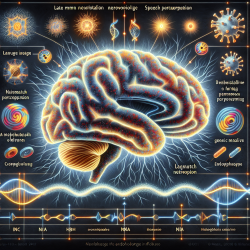Introduction to Dyslexia and the Late MMN Component
Dyslexia is a prevalent learning disorder affecting 5-10% of school-aged children, characterized by difficulties in reading and spelling despite normal intelligence and adequate schooling. Recent research has highlighted the potential of the late mismatch negativity (MMN) component as a neurophysiological endophenotype for dyslexia. This article will explore how practitioners can utilize these findings to enhance their practice and encourage further research in this domain.
Understanding the Late MMN
The MMN is an auditory event-related potential (AERP) component that reflects the brain's automatic response to changes in auditory stimuli. It is particularly relevant for studying speech perception as it does not require active attention from the individual. The late MMN, occurring between 300-700 ms, has been associated with higher cognitive processes, such as attention and long-term memory, which are critical in the context of dyslexia.
Research Findings on Late MMN and Dyslexia
The study "Evidence for the Late MMN as a Neurophysiological Endophenotype for Dyslexia" investigates the late MMN in children diagnosed with dyslexia, their unaffected siblings, and unrelated control children. The findings reveal that both dyslexic children and their unaffected siblings exhibit reduced late MMN compared to controls, suggesting a genetic influence on this component.
This attenuation in late MMN could serve as an endophenotype for dyslexia, bridging the gap between genetic predispositions and observable behavioral phenotypes. By identifying such endophenotypes, researchers can better understand the genetic underpinnings of dyslexia, potentially leading to improved diagnostic and intervention strategies.
Implications for Practitioners
For practitioners, these findings underscore the importance of incorporating neurophysiological assessments into the evaluation of dyslexia. By understanding the role of late MMN, practitioners can:
- Identify children at risk of dyslexia earlier, even before behavioral symptoms manifest.
- Tailor interventions to target specific cognitive processes associated with dyslexia, such as attention and memory.
- Collaborate with researchers to further explore the genetic basis of dyslexia and its neurophysiological markers.
Encouraging Further Research
The potential of late MMN as an endophenotype for dyslexia opens new avenues for research. Future studies could focus on:
- Replicating these findings in larger, more diverse populations to confirm the genetic influence on late MMN.
- Exploring the heritability of late MMN and its presence across dyslexic families.
- Investigating environmental factors or compensatory mechanisms that allow unaffected siblings to achieve normal reading and writing levels despite reduced late MMN.
Conclusion
The identification of late MMN as a potential endophenotype for dyslexia represents a significant advancement in understanding the disorder's neurophysiological and genetic dimensions. By integrating these insights into practice, speech-language pathologists can enhance their diagnostic and intervention strategies, ultimately improving outcomes for children with dyslexia.
To read the original research paper, please follow this link: Evidence for the Late MMN as a Neurophysiological Endophenotype for Dyslexia.










